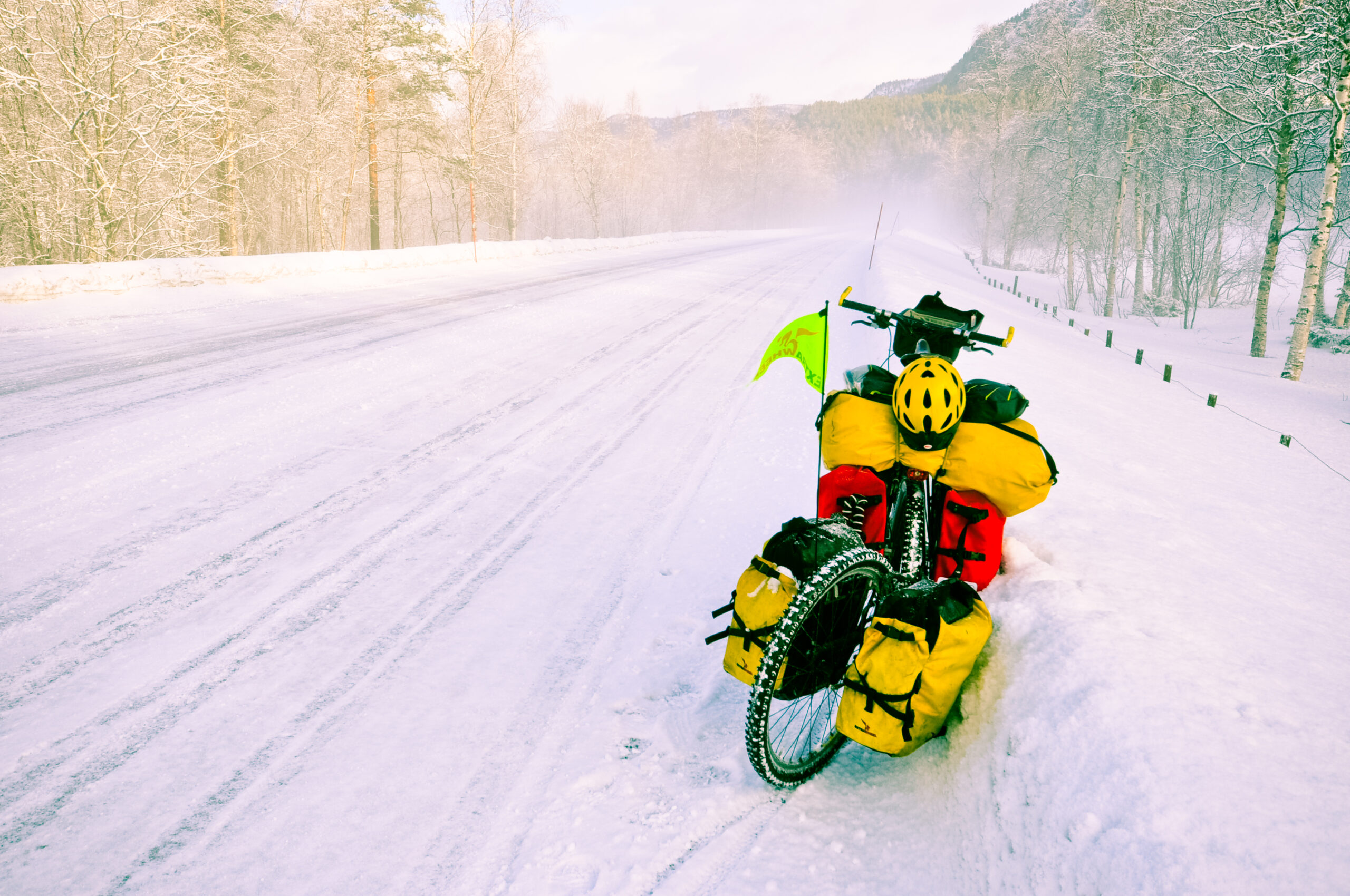A reader writes:
In February 2024, I’m finally going to realise my dream: I’m going to cycle from Rovaniemi to Tromso. I have a KTM Lontano Pinion 18. I’ve got a few questions:
- Do I need a special fluid for freezing temperatures for my hydrolic disc brakes?
- Do you think Schwalbe Winter Marathon plus 50–622 (240 spikes) are enough or do I really need Schwalbe Ice Spiker Pro 57–622 (402 spikes)?
Thank you for bringing up these timely questions on the subject of winter cycle touring in sub-zero conditions!
I myself rode to the Scandinavian Arctic back in the winter of 2011. It turns out that winter can be a source of fun and novelty for adventure cyclists, so it’s great to hear from someone planning a ride like this.
Let’s start with the question of whether you need special winter fluid for hydraulic disc brakes on a touring bike (or any other type of bicycle, for that matter).
It’s good to hear you’re thinking ahead about the potential for winter conditions to cause your bike and gear behave differently. They will, in many ways – and most of them are predictable, meaning you can prepare in advance.
In general, hydraulic braking systems use either mineral oil or automotive DOT fluid as their transmission medium. The good news is that both types of fluid function well at low temperatures, else they wouldn’t be an appropriate choice for systems such as brakes for cars and bikes, which let’s not forget are also sold in the countries you’re planning on riding through.
Having said that, the only way to guarantee the range of safe operating temperatures is to compare the specification of your brake fluid with the temperatures you’re likely to encounter. So let’s try and do that now.
The manufacturer webpage for your bike, the KTM Life Lontano P18, specifies Shimano BR-T615 brakes, which operate using Shimano’s own mineral oil (part number SM-DB-OIL).
Mineral oil could be argued to be a better choice than DOT fluid for very low temperatures, as it doesn’t absorb moisture over time. (Moisture absorption affects DOT fluid’s performance at extreme temperatures and is one of the reasons automotive brake fluid should be changed at regular intervals.)
However, “mineral oil” is a vague term, unlike DOT fluids whose performance characteristics are clearly defined. Unfortunately Shimano’s own website doesn’t seem to have any detailed information on the oil’s performance specifications, at least not that I could find.
This leads me to make the following educated guesses:
- It seems likely that a mainstream brake manufacturer would fill their brake systems with a fluid appropriate for a wide range of conditions, and at least issue a warning for special cases. The technical documents accompanying these brakes have no such warnings, so my guess is that cold weather should present no issues.
- Anecdotally, my Magura mineral oil-filled hydraulic disc brakes ran perfectly well in Arctic Scandinavia, so I’d imagine your Shimano mineral oil-filled brakes will too. (For the record, I encountered temperatures down to at least ‑33ºC.)
In short, if your brakes are well-maintained and checked before you leave, I think it’s highly unlikely you’ll have any problems related to the brake fluid. Frost-bitten fingers reducing your braking power seems more likely!
Regarding your choice of winter touring tyre, and particularly on choosing between Schwalbe’s Marathon Winter and Ice Spiker Pro tyres for cold weather cycle touring:
Both of these tyres have been in Schwalbe’s range of studded winter tyres for over a decade, and therefore are mature products road-tested over a huge number of real-world miles, so you can be pretty confident in their suitability for the task at hand. The question in your case is therefore more about the task than about the tyre.
Marathon Winters, as with the whole Marathon range, are designed primarily for general purpose longevity, with the studs added for grip on icy roads. The Ice Spiker Pros, on the other hand, are designed for mountain-biking in icy conditions, prioritising tyre volume and tread profile for maximum traction, as well as having almost double the number of studs as the Marathons. In other words, they’re different tyres for different jobs, albeit both in subzero conditions.
You haven’t mentioned anything about the details of your route. Judging by your choice of bike, I’d guess you’re planning on riding mainly on snowploughed roads and cycleways of hard-packed snow and ice, rather than going snow-biking on trails groomed for fatbike tyres or trying to venture off-road through deep snow. If I’m right about that, perhaps it will help if I say that in retrospect I’d have been able to accomplish my own Arctic cycle tour on the Marathon Winters, and I’d probably have found them to be more efficient in most of the circumstances I encountered. On the other hand, when I did go “off-road” and pedalled across the frozen surface of Lake Storsjön to Östersund, I was very happy to be able to let some air out of the Ice Spikers and have all 402 spikes in contact with the ice, even if only for peace of mind!
I hope this helps you prepare for your deep winter cycle tour, on which more of my advice can be found here. Don’t forget to let me (and everyone else here) know how you get on!
This is part of my “No Stupid Questions” series, in which readers write in with questions about cycle touring or bikepacking and I attempt to answer them. Check out more recent posts in the series or ask one of your own.


Something to add?